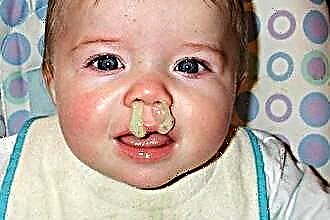Sinusitis is an inflammatory process in the maxillary sinuses of the nose, which primarily affects the mucous membrane of the organ. One of the main tasks of the mucous membranes of the nasal cavities (including the adventitious ones) is the protective function, which consists in binding and removing the pathogen from the body. Therefore, discharge with sinusitis is a completely understandable phenomenon and even good, since it indicates that the connecting channel is not completely blocked, and the outflow of exudate from the cavities is possible.
What does the color of the discharge mean in sinusitis?
 Due to the fact that the disease proceeds in a closed space of the maxillary sinus, by the consistency and color of the secreted secretion, it is possible to determine the stage of the disease and the main processes occurring in the organ, as well as the cause of the disease and the nature of the pathogen.
Due to the fact that the disease proceeds in a closed space of the maxillary sinus, by the consistency and color of the secreted secretion, it is possible to determine the stage of the disease and the main processes occurring in the organ, as well as the cause of the disease and the nature of the pathogen.
When making a diagnosis, the doctor must pay attention to the external characteristics of mucus to make an initial diagnosis and develop a treatment regimen.
Depending on the color of the snot with sinusitis, the stage of the disease is determined:
- Initial stage. It is called catarrhal sinusitis. The main characteristic is liquid, watery, transparent or odorless white discharge. At this stage, the main problem is to recognize the disease, since it is very similar in symptoms to a common rhinitis with a cold. Therefore, many adults try to be treated at home for colds until the characteristic signs of a more serious stage of the disease appear.
- Acute stage. Differs in catarrhal more severe course and the appearance of a purulent component in the mucus. Because of this, nasal discharge becomes yellow, greenish or brown, has a thick consistency, and often comes out in whole clots. If mucus is stained yellow, you should immediately consult a doctor, since at this stage conservative treatment is necessary, most often with the use of antibiotics.
- Recovery stage. With proper and timely therapy, under the influence of drugs, the symptoms of sinusitis begin to subside: congestion and headaches disappear. The color of snot at first remains yellow-green, then becomes white, their number decreases gradually until it disappears completely with final recovery.
- A neglected (severe) stage. Due to the edema of the anastomosis that connects the maxillary sinus to the nasal cavity, mucus stagnates in the sinus. It takes on a putrid, unpleasant odor and a gray-green color.
Also, by what kind of snot with sinusitis, an experienced otolaryngologist is able to recognize the cause of the development of the disease:
- Allergic sinusitis. It is characterized by a thin and clear discharge over a long period. The presence of concomitant symptoms, such as frequent sneezing, lacrimation, itching, make it possible to differentiate allergic sinusitis from catarrhal sinusitis in the initial stage.
 Sometimes a bacterial infection can join allergic sinusitis, then the secret turns yellow-green.
Sometimes a bacterial infection can join allergic sinusitis, then the secret turns yellow-green. - Dental sinusitis (odontogenic). It makes itself felt in the form of scanty gray-green discharge with a well-felt patient and an unpleasant odor around. It often goes along with diseases of the upper teeth and oral cavity.
- Fungal sinusitis. The mucus has an unpleasant odor. Its color is gray-green, includes blotches of various shades (white, black), depending on the fungus that provoked the disease.
Sometimes there is no discharge from the nose with sinusitis. This indicates that the connecting canal of the sinus is completely blocked due to severe edema or the presence of a mechanical obstruction (polyp, cyst). In such cases, drug therapy is often ineffective, so doctors use a method of surgical intervention - a puncture of the cavity (puncture), followed by forced evacuation of the accumulated exudate.
If the sinus drainage is not resumed in a timely manner, the infection may spread to nearby tissues.
The presence of blood in secret
The presence of blood clots or streaks of blood in the snot scares many patients, especially parents of sick children. They get the impression that this is a very dangerous sign that requires urgent medical attention. However, most often this is not the case, and the presence of traces of blood can occur in such cases:
- thin vascular walls, most often this is an innate property of a person;
- increased fragility of blood vessels due to various diseases, in particular, viral infections;
- long-term (over several weeks or months) use of nasal drops and sprays with a vasoconstrictor effect;
- blowing your nose too intensely, especially with severe swelling of the anastomosis, which creates a lot of tension in the blood vessels and can damage them;
- previously suffered damage to the bridge of the nose, provoking bleeding already in the early stages of sinusitis;
 mechanical damage to the mucous membrane and capillaries due to picking in the nasal passages with fingers or foreign objects.
mechanical damage to the mucous membrane and capillaries due to picking in the nasal passages with fingers or foreign objects.
The causes of bleeding with sinusitis can be other diseases to which the patient is susceptible: arterial hypertension, liver disease, diabetes mellitus. In this case, the doctor, when drawing up a treatment regimen and selecting the necessary drugs, must take into account the presence of other ailments in the patient. If the bleeding from the nose is severe and it is not possible to stop it with improvised means, an ambulance should be called.
Correct blowing your nose with sinusitis
Regular removal of discharge from the maxillary sinuses is necessary so that the secret does not stagnate in the chambers, and the ciliated cells of the mucous membrane can perform their function of removing exudate into the nasal cavity.
The easiest way to evacuate snot is by blowing your nose.
However, even in such a seemingly simple matter, there are subtleties:
- It should be blown out alternately each nostril, without applying undue effort. If the mucus does not go away, then the fistula is swollen, and the exit of fluid is complicated. Then you can apply a local or general drug with a vasoconstrictor component, and after its action, try to blow your nose again.
- You cannot blow your nose simultaneously in two nostrils, as this can lead to secretion entering the auditory tube and the development of inflammation of the inner ear. This is especially true for children in whom the Eustachian tube is wide and short, which contributes to the throwing of infected mucus into the auditory canal when blowing the nose incorrectly.
- It is necessary to remove the secret through the nasal passages. Pulling in the snot through the nasopharynx into the oral cavity and then spitting them out threatens the penetration of infection into the lower respiratory tract and the development of pharyngitis or laryngitis.
- You need to regularly change handkerchiefs or use disposable paper napkins. With prolonged use of a handkerchief, pathogenic microflora begins to actively develop in it. It is also undesirable to use scarves containing synthetic fibers in their composition, this can lead to irritation on the eve of the nose and on the edges of the nostrils.
Rinsing the nose with sinusitis
 Rinsing the nasal passages for inflammation of the maxillary cavities is a popular, effective and simple way to combat the disease. It can be used both in hospital and at home.
Rinsing the nasal passages for inflammation of the maxillary cavities is a popular, effective and simple way to combat the disease. It can be used both in hospital and at home.
The rinsing result is:
- liquefaction of the discharge with the facilitation of its subsequent removal from the sinuses;
- improving fluid drainage in a natural way;
- reduction of swelling of the mucous membranes;
- maintaining the immune function of the epithelium;
- toning of the capillary system of local blood circulation.
Saline solutions, medications and herbal tinctures are used to irrigate the nose. The most popular and effective ones are:
- Furacilin is an antimicrobial agent that has proven itself in the treatment of inflammatory and purulent diseases. It has practically no side effects, but it should be used with caution by people with kidney disease.
- Iodine solution (1-2 drops per glass of water). It is a cheap and readily available drug, but it can cause allergic reactions in some people. Contraindicated in children under 6 years of age, pregnant women and people suffering from serious illnesses.
- Aqua Maris is purified sea water containing natural minerals. Can be used for small children.
- Dolphin is a complex solution based on salts, minerals, organic elements and herbal extracts. Comes with a handy irrigation device. Contraindicated in children under 4 years of age and people with curvature of the nasal septum.
- Saline solutions. Can be prepared at home using warm boiled water and table or sea salt (half a teaspoon of salt in a glass of water). Before washing, it is advisable to strain the solution through several layers of gauze to eliminate possible mechanical impurities.
- Dioxidine. A potent antimicrobial agent that can only be used by adults, preferably after prior irrigation with normal saline.

Traditional medicine recommends rinsing your nose with solutions based on chamomile, celandine, propolis, oak bark, sage, eucalyptus, calendula, juice of some vegetables.
A syringe without a needle, a small syringe, or special devices that come with some products can be used to flush. Irrigation of the nasal cavity is carried out as follows:
- Before starting the procedure, the nose is thoroughly cleansed, it is important that it is not stuffy. To do this, you can use vasoconstrictor drops (Nazivin, Rinazolin) and start irrigation only after 15 minutes.
- The patient tilts his head slightly to one side over the bathtub, sink or bowl. The liquid is injected into the nostril located above, there is no need to create strong pressure, especially for children.
- The patient slowly tilts his head to the other side, and fluid flows out of the nostril naturally. Then the procedure is repeated with the other nostril.

 Sometimes a bacterial infection can join allergic sinusitis, then the secret turns yellow-green.
Sometimes a bacterial infection can join allergic sinusitis, then the secret turns yellow-green. mechanical damage to the mucous membrane and capillaries due to picking in the nasal passages with fingers or foreign objects.
mechanical damage to the mucous membrane and capillaries due to picking in the nasal passages with fingers or foreign objects.

